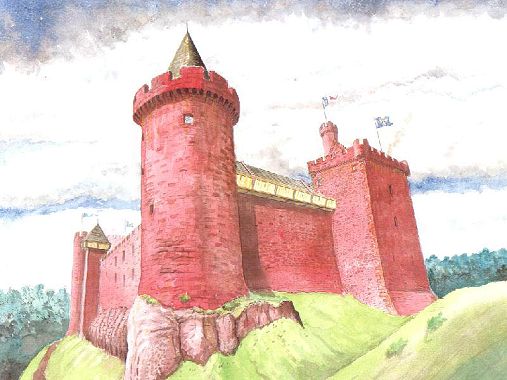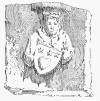Bothwell Castle
 Bothwell
Castle is one of Scotland’s greatest castles. It owes its origins to Walter of
Moray, a northern aristocratic family who acquired Bothwell in 1242. He (or his
son William, known as ‘the Rich’) created the mighty castle in a spectacular
display of feudal pride.
Bothwell
Castle is one of Scotland’s greatest castles. It owes its origins to Walter of
Moray, a northern aristocratic family who acquired Bothwell in 1242. He (or his
son William, known as ‘the Rich’) created the mighty castle in a spectacular
display of feudal pride.
Their dream was never completed, probably
because of the outbreak of the Wars of Independence in 1296. No matter, for what
they did achieve – and what still holds us enthralled today – is the great
donjon, or tower. Dr W. Douglas Simpson, erstwhile librarian of King’s College
at the University of Aberdeen, has justifiably described the building as ‘the
grandest piece of secular architecture that the Middle Ages has bequeathed to us
in Scotland’.
Not surprisingly, the Morays’ great castle figured
prominently in the Wars of Independence with England. Siege followed on siege.
The most momentous was Edward I’s great siege of 1301.
The Morays
envisaged a vast stone castle of enclosure covering 1.5 acres (0.75 hectares).
This was to have had a mighty twin-towered entrance gatehouse and other circular
towers projecting from its formidable curtain wall. Only the donjon, the main
residential tower, was ever fully built. It measured 20m in diameter, and stood
over 30m high. Although it was partially destroyed in 1337, it is still
remarkably impressive – one of the greatest military works of medieval Scotland.
In August 1301, when the Wars of Independence with England were at their
height, Bothwell endured a major siege. Edward I of England, ‘Hammer of the
Scots’, brought 6,800 soldiers to the castle. A huge siege engine, called le
berefrey (‘the belfry’), was hauled from Glasgow. It was a tall siege tower,
with ladders inside to enable the attackers to fight their way onto the castle
battlements. The garrison surrendered within the month.
After the wars,
Bothwell Castle passed to another powerful noble family, the Black Douglases.
They rebuilt it in a form not envisaged by their predecessors. This too is
impressive, with an array of fine-quality later-medieval secular architecture.
After the Black Douglases were overthrown in 1455, the castle reverted to the
Crown, and its later history was relatively uneventful.
After the last
recorded siege in 1337, the mighty donjon was partially dismantled. The castle
lay derelict until 1362, when Joanna Moray, heiress of Bothwell, married
Archibald ‘the Grim’, 3rd Earl of Black Douglas. Archibald and Joanna completely
rebuilt Bothwell to a different design. This included a lofty new tower house
(now gone), with a great hall and chapel beside it.
In 1758, Douglas
Castle burnt down, forcing Archibald, the Duke of Douglas
to find alternative
accommodation. He divided his time between
Holyrood Palace, where he had
apartments, and Bothwell Castle. He began the reconstruction of
Douglas Castle
(unfinished in his lifetime) to plans from John Adam, with the intention, it was
said, of building a house 10 feet wider and 10 feet higher than the duke of
Argyll's new seat at Inveraray.
By 1759, construction was underway on a
new Bothwell House -or perhaps a re-build of the existing one. Architect George
Paterson, possibly the same George Paterson who worked on Mount Stuart, altered
the house for the Duke.
The hall and chapel still stand, and are
impressive examples of later medieval castle architecture, and are open to the
public.
The name Bothwell is of Gaelic or Celtic origin and probably was used to
describe people from the lordship of Bothwell, located near Glasgow some 9 miles
(14 km) E of Uddingston in the South Lanarkshire region of Scotland.
There are several theories to explain the origin of the name, including one
rather fanciful one about how Archibald
"The Grim," third Earl of Douglas, was prompted by remorse to
found the Collegiate Church of St. Bride in 1398.
According to the legend, he summoned two of his best archers and ordered them
to aim at the rising sun and shoot their arrows as far as possible. Wherever the
furthest arrow landed was where the altar of the church would be placed.
When the arrows were found, they were side-by-side, whereupon the Earl is
said to have exclaimed "Both well shot."
However, since Bothwell Castle, where the Earl resided at that time, long
predated the founding of the church, the story is clearly apocryphal. (Bothwell
Castle was built by the Moray family in the 13th century. The castle later
passed into the hands of the "Black" Douglas family, then became the
property of the Crown in 1445 and was subsequently acquired by the Douglas
Earl of Forfar and the Earls of Home, who finally passed its ruined remains
into state care.)

A reconstruction drawing of Bothwell Castle showing how it might have looked around 1420.
Courtesy of Historic Environment Scotland

Douglas arms in Bothwell Castle
(click to enlarge)
See also:
Any contributions will be
gratefully accepted
Errors and Omissions
|
|
The Forum
|
|
What's new?
|
|
We are looking for your help to improve the accuracy of The Douglas
Archives.
If you spot errors, or omissions, then
please do let us know
Contributions
Many articles are stubs which would benefit from re-writing.
Can you help?
Copyright
You are not authorized to add this page or any images from this page
to Ancestry.com (or its subsidiaries) or other fee-paying sites
without our express permission and then, if given, only by including
our copyright and a URL link to the web site.
|
|
If you have met a brick wall
with your research, then posting a notice in the Douglas Archives
Forum may be the answer. Or, it may help you find the answer!
You may also be able to help others answer their queries.
Visit the
Douglas Archives Forum.
2 Minute Survey
To provide feedback on the website, please take a couple of
minutes to complete our
survey.
|
|
We try to keep everyone up to date with new entries, via our
What's New section on the
home page.
We also use
the Community
Network to keep researchers abreast of developments in the
Douglas Archives.
Help with costs
Maintaining the three sections of the site has its costs. Any
contribution the defray them is very welcome
Donate
Newsletter
If you would like to receive a very occasional newsletter -
Sign up!
Temporarily withdrawn.
|
|
|
|
|
|
|
|


